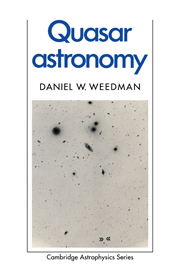8 - Emission line spectroscopy
Published online by Cambridge University Press: 18 December 2009
Summary
Introduction
Astronomy in the early part of this century demonstrated that galaxies were systems made of tremendous numbers of stars. Spectroscopy of galaxies revealed the absorption lines that would be expected in the composite light from stars of different spectral classes. Galaxies showing dominant emission lines in their spectra were recognized as highly unusual. The first of these to be studied, NGC 1068, was commented upon even before the real size and nature of galaxies were understood (Slipher 1918). For several decades, because of their rarity, such galaxies were sufficiently outside mainstream research as to be given little attention. The subject of emission line spectroscopy for extragalactic objects suddenly became extremely important with the discovery of quasars, whose visible spectra are characterized by strong emission lines. Emission lines can provide diagnostics of velocities, temperatures and densities unavailable from any other technique. The lines which can be seen represent a wide range of ionization, so line fluxes also provide indirect measurements of unobserved portions of the continuum. Not least is the fact that emission lines are spectroscopically conspicuous, calling attention to locations where unusual events are occurring. The general similarities among the emission line spectra of quasars, and the scaling of these lines with the continuum source, means that the emission line spectrum is a characteristic quasar feature. To understand the origin of these lines, it is necessary to review the general physical concepts of spectroscopy.
- Type
- Chapter
- Information
- Quasar Astronomy , pp. 164 - 187Publisher: Cambridge University PressPrint publication year: 1986



